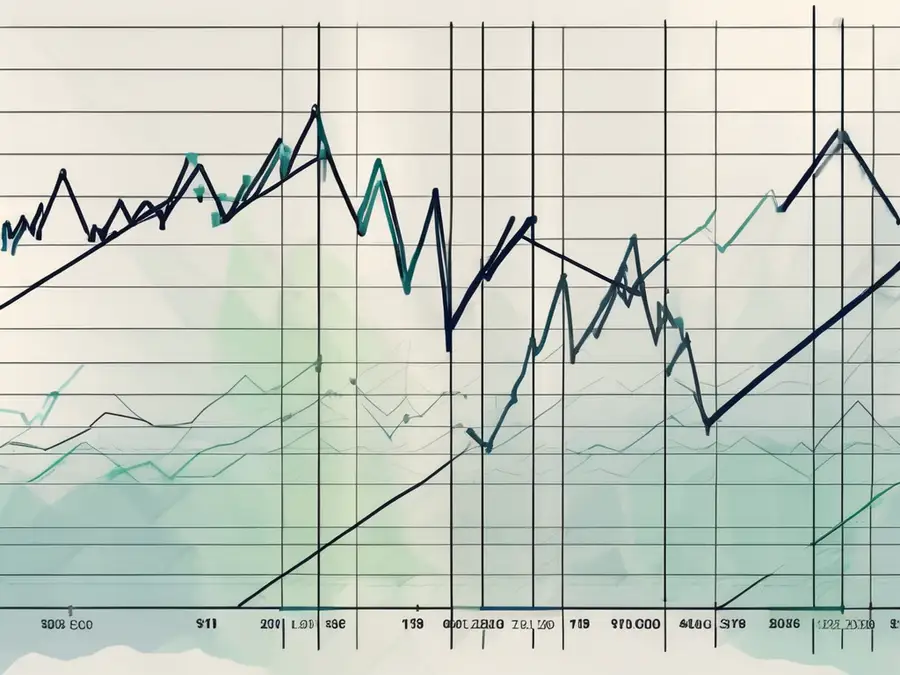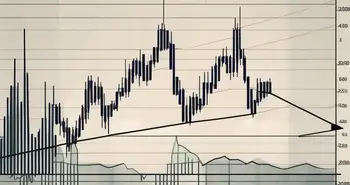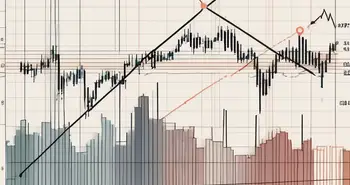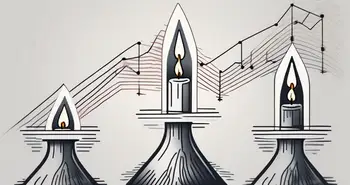Mastering the Ascending Triangle Pattern in Trading

Throughout my years as a trading expert, one pattern that has consistently caught my attention is the ascending triangle pattern. This powerful pattern has the potential to provide traders with valuable insights into future price movements. In this article, I will guide you through the intricacies of the ascending triangle pattern, from understanding its definition and characteristics to identifying it in charts, and ultimately devising effective trading strategies around it.
Understanding the Ascending Triangle Pattern
The ascending triangle pattern is a bullish continuation pattern that typically forms during an uptrend. It is characterized by a horizontal resistance level and an upward-sloping trendline that acts as support. This formation represents a period of consolidation before the price ultimately breaks out to the upside, resuming the previous uptrend.
When analyzing the ascending triangle pattern, it is important to consider its definition and characteristics. Ascending triangles can be identified by their distinct features. They consist of a series of higher lows that create the ascending trendline, while the horizontal resistance level connects multiple swing highs. This compression of price action creates a triangular shape, hence the pattern's name.
One key characteristic of the ascending triangle pattern is the diminishing supply and increasing demand. As the price approaches the horizontal resistance level, sellers become less willing to sell at lower prices, resulting in a squeeze between buyers and sellers. This imbalance sets the stage for a potential breakout and subsequent continuation of the uptrend.
The significance of the ascending triangle pattern in trading cannot be overlooked. It provides traders with a valuable indication of market sentiment. The pattern reflects a period of accumulation, indicating that buyers are gradually gaining control over sellers. This gradual shift in control suggests that the bullish momentum is likely to persist, making it a favorable setup for traders looking to capitalize on potential price movements.
Furthermore, the ascending triangle pattern can act as a confirmation tool for other technical indicators or fundamental analysis. When multiple signals align, it increases the probability of a successful trade, enhancing traders' confidence in their decision-making process.
Traders often use various strategies to trade the ascending triangle pattern. Some prefer to enter a long position when the price breaks above the horizontal resistance level, anticipating a continuation of the uptrend. Others may wait for a pullback to the trendline support before entering a long position, aiming for a better risk-reward ratio.
It is crucial to consider other factors when trading the ascending triangle pattern. Volume analysis can provide insights into the strength of the breakout. Higher volume during the breakout suggests greater conviction from market participants, increasing the likelihood of a sustained move to the upside.
Additionally, it is essential to monitor the overall market conditions and news events that may impact the pattern's outcome. Unexpected market developments or economic data releases can influence the pattern's validity and lead to false breakouts or reversals.
In conclusion, the ascending triangle pattern is a powerful tool in technical analysis. Its formation during an uptrend indicates a period of consolidation before a potential breakout to the upside. Traders can utilize this pattern to identify favorable trading opportunities and enhance their decision-making process. However, it is crucial to consider other factors and use proper risk management techniques when trading the ascending triangle pattern.
Identifying the Ascending Triangle Pattern in Charts
Identifying the ascending triangle pattern is a crucial step in effectively leveraging it for trading purposes. Let's explore key elements to look for when analyzing charts:
Key Elements to Look For
First and foremost, pay attention to the series of higher lows and the horizontal resistance level. These two elements are essential for classifying a formation as an ascending triangle. The series of higher lows indicates that buyers are becoming more aggressive and are willing to step in at higher prices, while the horizontal resistance level shows that sellers are preventing the price from moving higher.
It's also important to consider the volume during the consolidation phase. In general, volume tends to decline as the pattern develops, indicating a decrease in trading activity. This decrease in volume suggests that market participants are waiting for a breakout or a breakdown before committing to new positions.
Additionally, be mindful of the timeframe you're analyzing. Ascending triangles can form on various timeframes, so it's crucial to adapt your analysis accordingly. Remember that the longer the pattern takes to form, the more significant the potential breakout may be. Longer-term patterns tend to attract more attention from traders and can result in stronger price movements.
Common Mistakes in Identifying Ascending Triangles
While identifying ascending triangles, traders often fall prey to common mistakes that can lead to misguided decisions. One of the most prevalent errors is wrongly classifying a pattern as an ascending triangle when it is, in fact, a symmetrical triangle or a pennant. To avoid this mistake, carefully analyze the slope of the trendline and the structure of the pattern.
Another mistake to be mindful of is prematurely entering a trade before the breakout confirmation. It's essential to exercise patience and wait for a clear breach of the resistance level before initiating a position. Entering too early increases the risk of falling victim to a false breakout, which can result in losses. It's always better to wait for confirmation and trade with the trend rather than trying to predict the market's next move.
Furthermore, it's crucial to consider the overall market conditions and the presence of any significant news or events that could impact the price. These external factors can influence the reliability of the ascending triangle pattern and should be taken into account when making trading decisions.
Lastly, it's important to regularly review and reassess your analysis. Markets are dynamic, and patterns can evolve or fail to materialize. Stay updated with the latest price action and adjust your strategy accordingly to increase your chances of success.
Trading Strategies with Ascending Triangle Pattern
Now that we have grasped the fundamentals of the ascending triangle pattern, let's delve into some effective trading strategies revolving around this pattern.
The ascending triangle pattern is a bullish continuation pattern that indicates a potential upward trend in the market. It is formed by a horizontal resistance level and an upward sloping trendline that acts as support. Traders often look for this pattern as it can provide valuable insights into potential buying opportunities.
One popular approach is to enter a trade once the price breaks out above the horizontal resistance level. This breakout acts as a signal that the pattern has reached its completion and that buyers have gained control. Traders can set a stop-loss order just below the breakout point to manage risks.
However, it's important to note that not all breakouts are successful. False breakouts can occur, where the price briefly breaks above the resistance level but then quickly reverses. To avoid falling into this trap, traders may wait for a confirmation of the breakout, such as a strong close above the resistance level or an increase in trading volume.
As for exit points, consider taking profit when the price reaches a predetermined target based on technical analysis, such as a measured move. This involves measuring the height of the triangle and projecting it upwards from the breakout point. Alternatively, you may choose to employ a trailing stop-loss strategy to maximize gains and protect your profits as the price continues to rally.
However, it's important to be mindful of potential false breakouts or price reversals. Traders should continuously monitor the market and adjust their exit strategy accordingly to avoid missing out on potential profits or sustaining unnecessary losses.
Risk Management in Ascending Triangle Trading
Effective risk management is crucial in trading, and utilizing ascending triangles is no exception. Traders should always define their risk tolerance and set appropriate stop-loss levels based on their individual trading strategies. It's important to remember that not all trades will be successful, and risk management is key to long-term success.
Furthermore, traders should consider the overall market conditions and the volatility of the stock or asset being traded. Higher volatility may require wider stop-loss levels to account for potential price fluctuations, while lower volatility may allow for tighter stop-loss levels.
Additionally, adjusting position size according to the overall risk of the trade can help manage exposure. By properly managing risk, traders can ensure that potential losses are limited while preserving the opportunity for significant gains.
It's also essential to stay updated with market news and events that may impact the price movement of the asset being traded. Unexpected news, such as economic data releases or geopolitical events, can lead to increased volatility and potentially affect the success of the trading strategy.
In conclusion, trading strategies with the ascending triangle pattern can be effective in identifying potential buying opportunities and managing risk. However, it's important to exercise caution, conduct thorough analysis, and continuously monitor the market to make informed trading decisions.
The Role of Volume in Ascending Triangle Pattern
When analyzing the ascending triangle pattern, it's essential to consider the role of volume as a confirming indicator. Understanding how volume behaves during different phases of the pattern can provide valuable insights into market dynamics and potential trading opportunities.
Interpreting Volume in Ascending Triangle Formation
During the consolidation phase of the ascending triangle pattern, volume tends to diminish. This decrease in volume signals a lack of interest or indecision among market participants. Traders should pay attention to this decline as it signifies a potential buildup of tension and an impending breakout.
As the price moves within the boundaries of the ascending triangle, market participants may adopt a wait-and-see approach, resulting in lower trading volumes. This decrease in volume can be seen as a reflection of the market's uncertainty and the battle between buyers and sellers. It is important to note that while volume diminishes, it does not necessarily mean that the pattern is invalidated. Instead, it suggests that market participants are patiently awaiting a catalyst for a decisive move.
During this consolidation phase, the diminishing volume can also be interpreted as a coiling spring, with potential energy building up. Traders who recognize this pattern may position themselves for a potential breakout, anticipating a surge in volume and a subsequent price movement.
Volume and Breakouts in Ascending Triangles
Volume plays a crucial role when a breakout occurs in an ascending triangle pattern. Ideally, a breakout accompanied by a surge in volume confirms the validity of the pattern, increasing the likelihood of a sustainable move. Traders should closely monitor the volume during the breakout to validate their trading decisions.
When a breakout happens, it signifies a shift in market sentiment and a potential change in the supply-demand dynamics. An increase in volume during the breakout suggests a strong conviction among market participants, as more traders enter the market to capitalize on the anticipated price movement.
However, it is important to note that volume alone should not be the sole factor for making trading decisions. Traders should also consider other technical indicators and price action to confirm the validity of the breakout. False breakouts, where volume surges but the price fails to sustain the move, can lead to significant losses if traders solely rely on volume as a confirmation signal.
Furthermore, analyzing volume patterns after the breakout can provide additional insights into the strength of the move. If the volume remains high or continues to increase after the breakout, it suggests a sustained interest and potential continuation of the trend. On the other hand, a decrease in volume after the breakout may indicate a lack of follow-through and a potential reversal or consolidation.
In conclusion, volume analysis is an important tool when analyzing ascending triangle patterns. Understanding how volume behaves during different phases of the pattern can provide valuable insights into market dynamics and potential trading opportunities. By closely monitoring volume during the consolidation phase and breakout, traders can enhance their decision-making process and increase the probability of successful trades.
Limitations of the Ascending Triangle Pattern
While the ascending triangle pattern can provide valuable insights, it's essential to be aware of its limitations and potential challenges.
The ascending triangle pattern is a popular technical analysis tool used by traders to identify potential breakouts. It is formed by drawing a horizontal line along the swing highs and an ascending trendline along the swing lows. The convergence of these two lines creates a triangle shape, indicating a potential bullish continuation pattern.
False Breakouts and How to Handle Them
False breakouts are a common occurrence in trading, and the ascending triangle pattern is not exempt from them. Traders may encounter instances where the price breaches the resistance level but quickly reverses, trapping those who entered trades based on the breakout.
To mitigate the risk of false breakouts, it's advisable to wait for confirmation. Consider waiting for a candlestick close above the resistance level or monitor volume for sustained momentum. Applying additional technical tools like trendline breaks or moving averages can offer further confirmation.
False breakouts can be frustrating for traders, as they can lead to losses and missed opportunities. However, by exercising patience and waiting for confirmation, traders can increase their chances of entering successful trades.
Market Conditions and Their Impact on Ascending Triangles
Market conditions can significantly influence the efficacy of the ascending triangle pattern. In a highly volatile market, the pattern may be more prone to false breakouts due to increased market noise. Consequently, traders should exercise caution when trading ascending triangles during periods of heightened volatility and adapt their strategies accordingly.
It's important to consider the broader market context when analyzing ascending triangles. Factors such as economic news, geopolitical events, and market sentiment can all impact the pattern's reliability. Traders should be mindful of these factors and adjust their trading decisions accordingly.
As an expert in the field, I have personally witnessed the power of the ascending triangle pattern in my trading journey. Its ability to provide timely and reliable signals has proven invaluable. By mastering this pattern and combining it with prudent risk management techniques, traders can increase their chances of success in the ever-evolving world of trading.
In conclusion, while the ascending triangle pattern is a useful tool for traders, it is not without its limitations. False breakouts and market conditions can pose challenges, but with proper analysis and risk management, traders can navigate these obstacles and capitalize on the pattern's potential.
FAQ – Frequently Asked Questions
What is the ascending triangle pattern?
The ascending triangle pattern is a bullish continuation pattern that forms during uptrends. It consists of a horizontal resistance level and an upward-sloping trendline acting as support.
How can I identify the ascending triangle pattern in charts?
Look for a series of higher lows and a horizontal resistance level. The pattern should have diminishing volume as it develops, confirming the consolidation phase.
What is the significance of the ascending triangle pattern in trading?
The ascending triangle pattern indicates buyers gaining control over sellers during a consolidation phase. It suggests the continuation of an uptrend and can act as a confirmation tool for other technical indicators or fundamental analysis.
What are some common mistakes to avoid when identifying ascending triangles?
Common mistakes include misclassifying other patterns as ascending triangles and prematurely entering trades before a clear breakout confirmation. Patience and careful analysis are critical to avoid these pitfalls.
What are some effective trading strategies with the ascending triangle pattern?
One strategy is to enter a trade once the price breaks out above the resistance level. Manage risks with a stop-loss order and consider taking profit based on technical analysis targets or a trailing stop-loss strategy.
How does volume play a role in ascending triangle patterns?
Volume tends to diminish during the consolidation phase of an ascending triangle, signaling a potential breakout. During the breakout, a surge in volume validates the pattern and increases the chances of a sustainable move.
What are the limitations of the ascending triangle pattern?
False breakouts and challenges during highly volatile market conditions are limitations of the ascending triangle pattern. Waiting for confirmation and adapting strategies to market conditions can help navigate these challenges effectively.
In conclusion, the ascending triangle pattern is a powerful tool for traders to master. By understanding its characteristics, accurately identifying it in charts, and devising effective trading strategies, traders can optimize their decision-making process and enhance their chances of success. Remember to consistently practice risk management and adapt to market conditions for long-term profitability.
Ready to put your knowledge of the ascending triangle pattern into action? Join Morpher, the revolutionary trading platform that empowers you with zero fees, infinite liquidity, and the flexibility of fractional investing. Whether you're looking to trade stocks, cryptocurrencies, forex, or even niche markets, Morpher's blockchain-based platform offers a unique trading experience with up to 10x leverage and the safety of a non-custodial wallet. Sign Up and Get Your Free Sign Up Bonus today to start trading on a platform that's as innovative as your trading strategies.

Disclaimer: All investments involve risk, and the past performance of a security, industry, sector, market, financial product, trading strategy, or individual’s trading does not guarantee future results or returns. Investors are fully responsible for any investment decisions they make. Such decisions should be based solely on an evaluation of their financial circumstances, investment objectives, risk tolerance, and liquidity needs. This post does not constitute investment advice.

Painless trading for everyone
Hundreds of markets all in one place - Apple, Bitcoin, Gold, Watches, NFTs, Sneakers and so much more.

Painless trading for everyone
Hundreds of markets all in one place - Apple, Bitcoin, Gold, Watches, NFTs, Sneakers and so much more.









